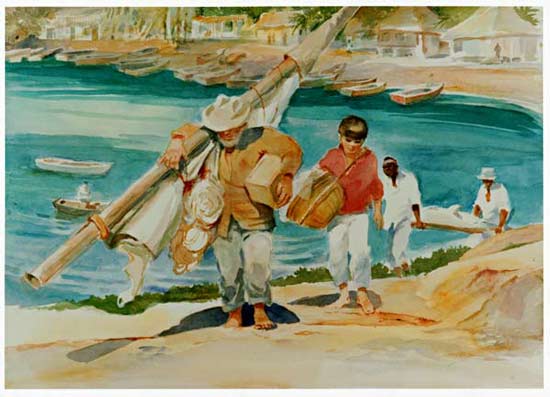The first day of the story introduces the old man, Santiago, and the young boy that helps him, Manolin. It tells of Santiago’s history and that Manolin used to work with the old man until his parents made him go fish with another man forty days into Santiago’s unlucky streak of not catching fish. Manolin helps Santiago by carrying his supplies home with him and getting food even though Santiago is too prideful to ask for assistance. Manolin helps the old man even though he has no obligation to him. Some fishermen laugh at the old man because of his bad luck, while the older fishermen feel bad for Santiago. Day one of the novel explains how the fish market works; how the fish and sharks of butchered. Santiago and Manolin reminisce about their past fishing expeditions. Manolin wants to get the old man four baits but the prideful Santiago compromises with the boy to giving him to pieces of bait. Santiago lives in a small shack with minimal furniture and only two pictures that had belonged to his wife, the Sacred Heart of Jesus and the Virgin of Cobre. The boy and the old man go through a routine everyday where Santiago lies to Manolin about food and fishing supplies he doesn’t have. The next day will be Santiago’s 85th day without catching a fish and there is foreshadowing about 85 being a lucky number. This day also introduces the old man’s thoughts on Joe DiMaggio, a Yankee baseball player, Santiago’s admiration for him and how he thinks they would understand each other. Once Santiago goes to bed he dreams of Africa, but when he usually wakes when he smells the land breeze, that night he continued dreaming. He dreamed about lions dancing on the beaches of Africa. His dream of the lions is significant in some way. The lions may represent youth and strength, which could reflect the traits Santiago wishes he still had.
Santiago’s character is introduced as an old fisherman in the Gulf Stream who is poor, yet prideful. It explains his 84 days unlucky streak and provides his appearance as having many wrinkles, scars, and skin cancer from a lifetime of fishing. Manolin is the young boy Santiago loves like a son. He always tries to help Santiago and the reader can tell he is a kind and caring person because he has no obligation to Santiago, but continually tries to makes his life better.
Santiago’s dream is significant because it helps the reader detect Santiago’s personality and it foreshadows to events that will probably happen where Santiago could uses the youthfulness and the strength of the lions. Santiago saying that 85 is a lucky number which impliess that something important will happen tomorrow. The novel mentioning Joe DiMaggio has some significance because Santiago looks up to him.
This story has lots of descriptive imagery which helps immerse the reader into the setting and story. The imagery tells the reader how tough Santiago’s life has been be describing his appearance and also explaining his living conditions. Even through all the sad and tough images given there are also a lot of beautiful scenes depicted, like his dreams of Africa and the lions playing on the beach.
